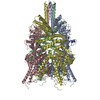+ データを開く
データを開く
- 基本情報
基本情報
| 登録情報 | データベース: PDB / ID: 6cud | ||||||
|---|---|---|---|---|---|---|---|
| タイトル | Structure of the human TRPC3 in a lipid-occupied, closed state | ||||||
 要素 要素 | Short transient receptor potential channel 3 | ||||||
 キーワード キーワード | MEMBRANE PROTEIN / Canonical transient receptor potential 3 (TRPC3) lipid-sensitive non-selective cation channel | ||||||
| 機能・相同性 |  機能・相同性情報 機能・相同性情報positive regulation of cardiac muscle hypertrophy in response to stress / Role of second messengers in netrin-1 signaling / store-operated calcium channel activity / Effects of PIP2 hydrolysis / Elevation of cytosolic Ca2+ levels / inositol 1,4,5 trisphosphate binding / calcium-activated cation channel activity / cation channel complex / TRP channels / response to ATP ...positive regulation of cardiac muscle hypertrophy in response to stress / Role of second messengers in netrin-1 signaling / store-operated calcium channel activity / Effects of PIP2 hydrolysis / Elevation of cytosolic Ca2+ levels / inositol 1,4,5 trisphosphate binding / calcium-activated cation channel activity / cation channel complex / TRP channels / response to ATP / positive regulation of calcium ion transport into cytosol / phototransduction / regulation of cytosolic calcium ion concentration / single fertilization / MECP2 regulates neuronal receptors and channels / response to calcium ion / calcium ion transmembrane transport / calcium channel activity / calcium ion transport / metal ion binding / plasma membrane 類似検索 - 分子機能 | ||||||
| 生物種 |  Homo sapiens (ヒト) Homo sapiens (ヒト) | ||||||
| 手法 | 電子顕微鏡法 / 単粒子再構成法 / クライオ電子顕微鏡法 / 解像度: 3.3 Å | ||||||
 データ登録者 データ登録者 | Lu, W. / Du, J. / Fan, C. / Choi, W. | ||||||
 引用 引用 |  ジャーナル: Elife / 年: 2018 ジャーナル: Elife / 年: 2018タイトル: Structure of the human lipid-gated cation channel TRPC3. 著者: Chen Fan / Wooyoung Choi / Weinan Sun / Juan Du / Wei Lü /  要旨: The TRPC channels are crucially involved in store-operated calcium entry and calcium homeostasis, and they are implicated in human diseases such as neurodegenerative disease, cardiac hypertrophy, and ...The TRPC channels are crucially involved in store-operated calcium entry and calcium homeostasis, and they are implicated in human diseases such as neurodegenerative disease, cardiac hypertrophy, and spinocerebellar ataxia. We present a structure of the full-length human TRPC3, a lipid-gated TRPC member, in a lipid-occupied, closed state at 3.3 Angstrom. TRPC3 has four elbow-like membrane reentrant helices prior to the first transmembrane helix. The TRP helix is perpendicular to, and thus disengaged from, the pore-lining S6, suggesting a different gating mechanism from other TRP subfamily channels. The third transmembrane helix S3 is remarkably long, shaping a unique transmembrane domain, and constituting an extracellular domain that may serve as a sensor of external stimuli. We identified two lipid-binding sites, one being sandwiched between the pre-S1 elbow and the S4-S5 linker, and the other being close to the ion-conducting pore, where the conserved LWF motif of the TRPC family is located. | ||||||
| 履歴 |
|
- 構造の表示
構造の表示
| ムービー |
 ムービービューア ムービービューア |
|---|---|
| 構造ビューア | 分子:  Molmil Molmil Jmol/JSmol Jmol/JSmol |
- ダウンロードとリンク
ダウンロードとリンク
- ダウンロード
ダウンロード
| PDBx/mmCIF形式 |  6cud.cif.gz 6cud.cif.gz | 473.6 KB | 表示 |  PDBx/mmCIF形式 PDBx/mmCIF形式 |
|---|---|---|---|---|
| PDB形式 |  pdb6cud.ent.gz pdb6cud.ent.gz | 383.5 KB | 表示 |  PDB形式 PDB形式 |
| PDBx/mmJSON形式 |  6cud.json.gz 6cud.json.gz | ツリー表示 |  PDBx/mmJSON形式 PDBx/mmJSON形式 | |
| その他 |  その他のダウンロード その他のダウンロード |
-検証レポート
| 文書・要旨 |  6cud_validation.pdf.gz 6cud_validation.pdf.gz | 1.1 MB | 表示 |  wwPDB検証レポート wwPDB検証レポート |
|---|---|---|---|---|
| 文書・詳細版 |  6cud_full_validation.pdf.gz 6cud_full_validation.pdf.gz | 1.1 MB | 表示 | |
| XML形式データ |  6cud_validation.xml.gz 6cud_validation.xml.gz | 74.4 KB | 表示 | |
| CIF形式データ |  6cud_validation.cif.gz 6cud_validation.cif.gz | 111.1 KB | 表示 | |
| アーカイブディレクトリ |  https://data.pdbj.org/pub/pdb/validation_reports/cu/6cud https://data.pdbj.org/pub/pdb/validation_reports/cu/6cud ftp://data.pdbj.org/pub/pdb/validation_reports/cu/6cud ftp://data.pdbj.org/pub/pdb/validation_reports/cu/6cud | HTTPS FTP |
-関連構造データ
- リンク
リンク
- 集合体
集合体
| 登録構造単位 | 
|
|---|---|
| 1 |
|
- 要素
要素
| #1: タンパク質 | 分子量: 92691.242 Da / 分子数: 4 / 由来タイプ: 組換発現 / 由来: (組換発現)  Homo sapiens (ヒト) / 遺伝子: TRPC3, TRP3 / 発現宿主: Homo sapiens (ヒト) / 遺伝子: TRPC3, TRP3 / 発現宿主:  Homo sapiens (ヒト) / 参照: UniProt: Q13507 Homo sapiens (ヒト) / 参照: UniProt: Q13507#2: 化合物 | ChemComp-6OE / ( #3: 化合物 | ChemComp-FGJ / ( #4: 糖 | ChemComp-NAG / Has protein modification | Y | |
|---|
-実験情報
-実験
| 実験 | 手法: 電子顕微鏡法 |
|---|---|
| EM実験 | 試料の集合状態: PARTICLE / 3次元再構成法: 単粒子再構成法 |
- 試料調製
試料調製
| 構成要素 | 名称: TRPC3 / タイプ: COMPLEX / Entity ID: #1 / 由来: RECOMBINANT |
|---|---|
| 分子量 | 値: 0.39 MDa / 実験値: NO |
| 由来(天然) | 生物種:  Homo sapiens (ヒト) Homo sapiens (ヒト) |
| 由来(組換発現) | 生物種:  Homo sapiens (ヒト) Homo sapiens (ヒト) |
| 緩衝液 | pH: 8 |
| 試料 | 包埋: NO / シャドウイング: NO / 染色: NO / 凍結: YES |
| 急速凍結 | 凍結剤: ETHANE |
- 電子顕微鏡撮影
電子顕微鏡撮影
| 実験機器 |  モデル: Titan Krios / 画像提供: FEI Company |
|---|---|
| 顕微鏡 | モデル: FEI TITAN KRIOS |
| 電子銃 | 電子線源:  FIELD EMISSION GUN / 加速電圧: 300 kV / 照射モード: FLOOD BEAM FIELD EMISSION GUN / 加速電圧: 300 kV / 照射モード: FLOOD BEAM |
| 電子レンズ | モード: BRIGHT FIELD |
| 撮影 | 電子線照射量: 6.76 e/Å2 / 検出モード: SUPER-RESOLUTION フィルム・検出器のモデル: GATAN K2 SUMMIT (4k x 4k) |
- 解析
解析
| EMソフトウェア | 名称: FREALIGN / バージョン: 9 / カテゴリ: 3次元再構成 |
|---|---|
| CTF補正 | タイプ: PHASE FLIPPING AND AMPLITUDE CORRECTION |
| 対称性 | 点対称性: C4 (4回回転対称) |
| 3次元再構成 | 解像度: 3.3 Å / 解像度の算出法: FSC 0.143 CUT-OFF / 粒子像の数: 143855 / 対称性のタイプ: POINT |
 ムービー
ムービー コントローラー
コントローラー










 PDBj
PDBj










